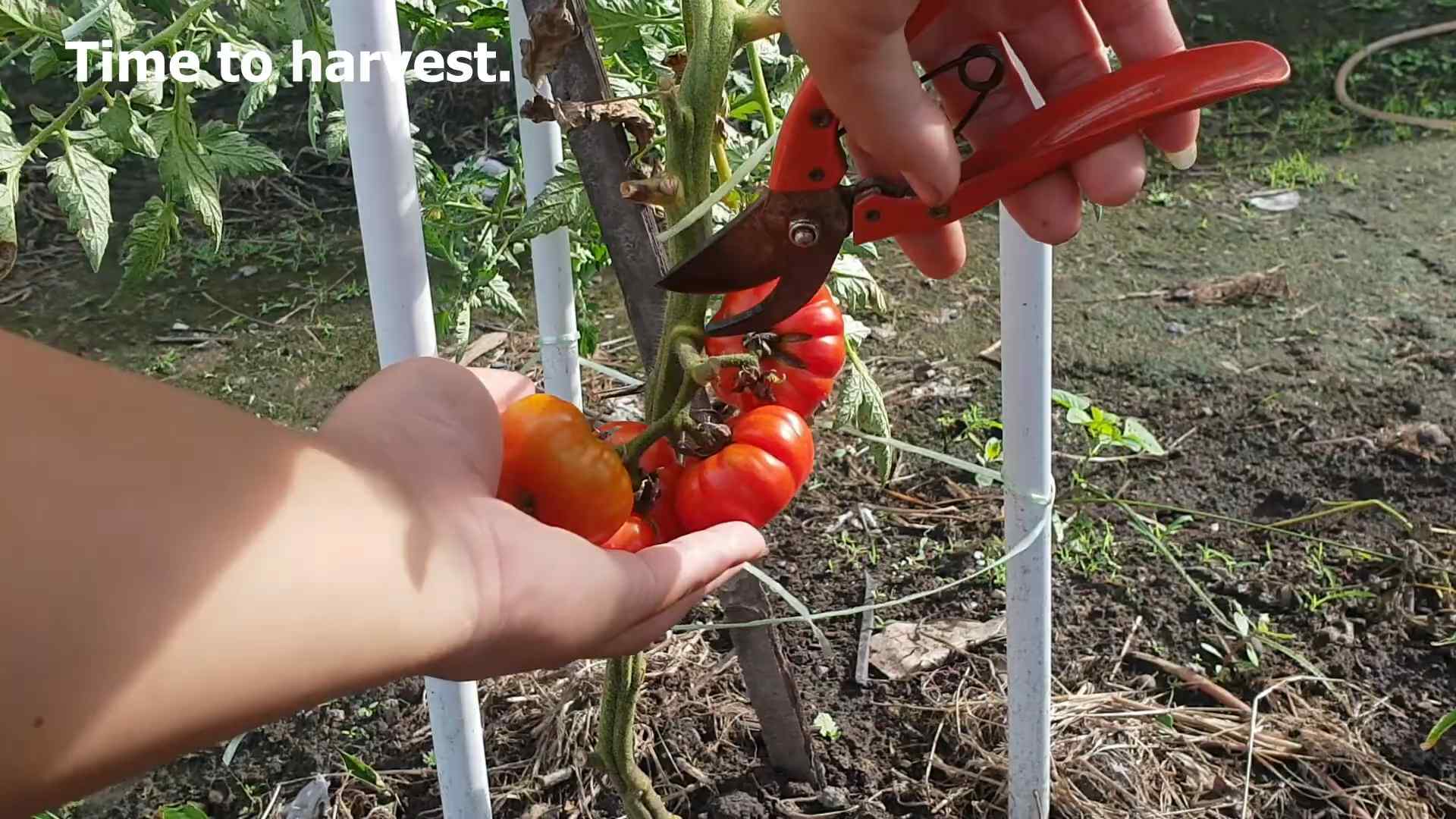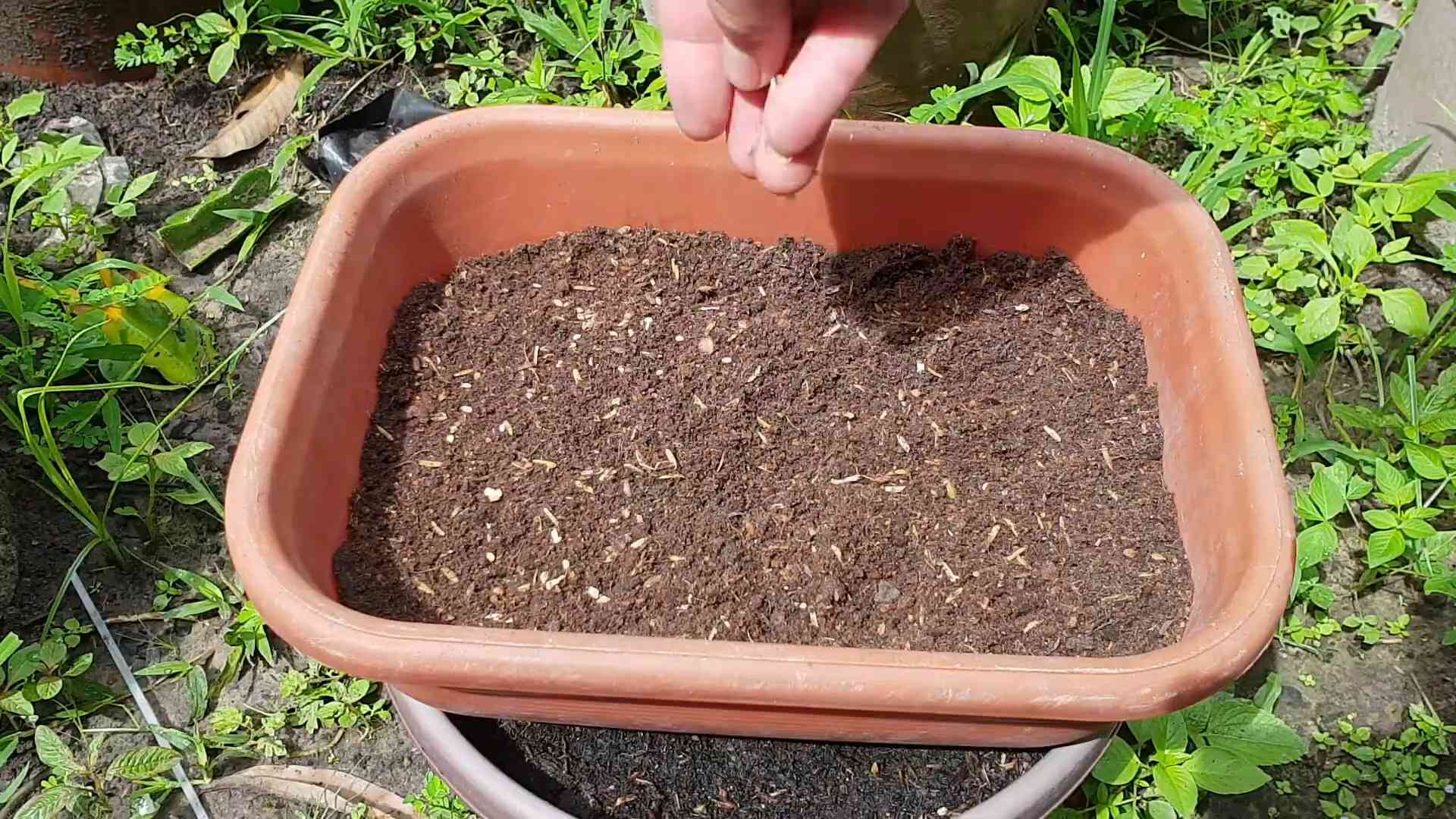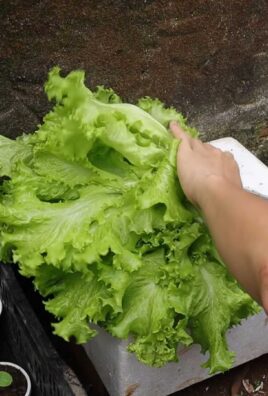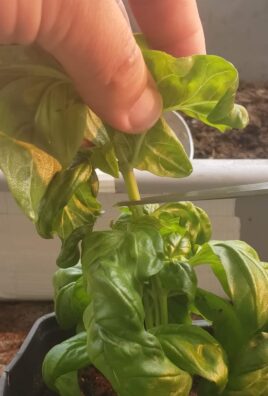Grow Heirloom Tomatoes Indoors and savor the taste of summer, even when the snow is falling! Imagine biting into a juicy, flavorful tomato bursting with sunshine, all thanks to your own indoor garden. Forget those bland, store-bought tomatoes – with a few simple tricks, you can cultivate vibrant heirloom varieties right in your home.
Heirloom tomatoes, passed down through generations, boast unique flavors and colors that are often lost in commercial agriculture. These varieties represent a living history, connecting us to the past through their rich heritage. For centuries, gardeners have carefully preserved these seeds, ensuring that these exceptional flavors continue to thrive.
But why should you bother learning to grow heirloom tomatoes indoors? Well, for starters, you gain complete control over the growing process, ensuring organic and pesticide-free produce. Plus, you can extend the growing season, enjoying fresh tomatoes long after your outdoor garden has gone dormant. In this article, I’ll share my favorite DIY tricks and hacks to help you successfully cultivate these delicious treasures indoors, transforming your home into a miniature tomato paradise. Get ready to impress your friends and family with your homegrown bounty!

Growing Heirloom Tomatoes Indoors: A Comprehensive Guide
Hey there, fellow gardening enthusiasts! Ever dreamt of biting into a juicy, sun-ripened heirloom tomato in the dead of winter? Well, dream no more! I’m going to walk you through the process of growing these flavorful beauties indoors, so you can enjoy that garden-fresh taste year-round. It might seem daunting, but trust me, with a little patience and the right setup, you’ll be harvesting your own heirloom tomatoes in no time.
Choosing the Right Heirloom Variety
First things first, not all heirloom tomatoes are created equal when it comes to indoor growing. Some varieties are just too large and sprawling to thrive in a confined space. We need to pick varieties that are more compact and determinate, meaning they grow to a certain size and then stop, rather than vining endlessly.
Here are a few of my favorite heirloom varieties that do well indoors:
* ‘Tiny Tim’: As the name suggests, these are super compact and perfect for small spaces. They produce small, cherry-sized tomatoes.
* ‘Roma’: A classic paste tomato, ‘Roma’ plants are relatively compact and produce a good yield.
* ‘Patio’: Bred specifically for container gardening, ‘Patio’ tomatoes are naturally dwarf and produce medium-sized fruits.
* ‘Micro Tom’: These are the smallest tomato plants you can find, growing only about 6-8 inches tall. They’re perfect for a windowsill!
* ‘Black Krim’: While typically larger outdoors, ‘Black Krim’ can be successfully grown indoors with proper pruning and support. The flavor is worth the effort!
Setting Up Your Indoor Tomato Garden
Before we even think about planting, let’s get our indoor garden ready. This is crucial for success!
* Lighting: This is the most important factor. Tomatoes need at least 6-8 hours of direct sunlight per day. If you don’t have a sunny south-facing window, you’ll need to invest in grow lights.
* Types of Grow Lights: LED grow lights are the most energy-efficient and produce very little heat. Fluorescent grow lights (T5 or T8) are also a good option, but they need to be placed closer to the plants.
* Light Placement: Position your grow lights about 6-12 inches above the plants. You may need to adjust the height as the plants grow.
* Containers: Choose containers that are at least 5 gallons in size for determinate varieties and 10 gallons for indeterminate varieties like ‘Black Krim’. Make sure the containers have drainage holes!
* Potting Mix: Use a high-quality potting mix that is well-draining and contains plenty of organic matter. Avoid using garden soil, as it can compact and not drain well in containers. I like to use a mix of peat moss, perlite, and vermiculite.
* Temperature: Tomatoes thrive in temperatures between 65-85°F (18-29°C). Avoid placing your plants near drafty windows or heating vents.
* Air Circulation: Good air circulation is essential to prevent fungal diseases. A small fan can help to circulate the air around your plants.
Planting Your Heirloom Tomato Seeds
Now for the fun part! Let’s get those seeds started.
1. Start Seeds Indoors (6-8 weeks before last frost): Fill seed starting trays or small pots with seed starting mix. Moisten the mix thoroughly.
2. Sow Seeds: Plant the seeds about 1/4 inch deep and gently cover them with soil.
3. Water Gently: Water the seeds gently using a spray bottle or watering can with a fine rose.
4. Provide Warmth: Place the seed trays or pots in a warm location, such as on top of a refrigerator or on a heat mat. The ideal temperature for germination is 70-80°F (21-27°C).
5. Maintain Moisture: Keep the soil consistently moist, but not soggy. Cover the seed trays with a plastic dome or plastic wrap to help retain moisture.
6. Germination: The seeds should germinate in 5-10 days. Once the seedlings emerge, remove the plastic dome or wrap and place them under grow lights or in a sunny window.
7. Thin Seedlings: Once the seedlings have their first true leaves (the second set of leaves), thin them out so that only the strongest seedling remains in each pot.
Transplanting Your Seedlings
Once your seedlings have grown a few inches tall and have a strong root system, it’s time to transplant them into their final containers.
1. Harden Off Seedlings: Before transplanting, you need to “harden off” the seedlings. This means gradually exposing them to outdoor conditions over a period of 7-10 days. Start by placing them outdoors in a sheltered location for a few hours each day, gradually increasing the amount of time they spend outdoors.
2. Prepare Containers: Fill your chosen containers with the potting mix.
3. Transplant Seedlings: Gently remove the seedlings from their seed starting trays or pots and transplant them into the containers. Plant them slightly deeper than they were growing before, as this will encourage the development of a stronger root system.
4. Water Thoroughly: Water the transplanted seedlings thoroughly.
5. Provide Support: If you’re growing indeterminate varieties, you’ll need to provide support for the plants. Use stakes, cages, or trellises to support the stems as they grow.
Caring for Your Indoor Tomato Plants
Now that your tomato plants are in their final containers, it’s time to provide them with the care they need to thrive.
* Watering: Water your tomato plants regularly, keeping the soil consistently moist but not soggy. Water deeply, allowing the water to drain out of the drainage holes. Avoid watering the foliage, as this can encourage fungal diseases.
* Fertilizing: Tomatoes are heavy feeders, so you’ll need to fertilize them regularly. Use a balanced fertilizer that is specifically formulated for tomatoes. Follow the instructions on the fertilizer label. I like to use a liquid fertilizer diluted to half strength every two weeks.
* Pruning: Pruning is essential for indoor tomato plants, especially indeterminate varieties. Remove suckers (the small shoots that grow between the main stem and the branches) to encourage the plant to focus its energy on producing fruit.
* Pollination: Indoor tomatoes may need help with pollination. You can hand-pollinate the flowers by gently shaking the plants or using a small paintbrush to transfer pollen from one flower to another. A small fan blowing on the plants can also help with pollination.
* Pest and Disease Control: Keep an eye out for pests and diseases. Common pests include aphids, whiteflies, and spider mites. Common diseases include powdery mildew and blossom end rot. Treat any problems promptly with organic pest control methods or fungicides. Neem oil is a great all-purpose solution.
* Rotating Plants: Rotate your plants regularly to ensure that all sides receive equal light exposure.
Harvesting Your Heirloom Tomatoes
The moment we’ve all been waiting for! Harvesting your delicious, homegrown heirloom tomatoes.
1. Ripeness: Tomatoes are ready to harvest when they are fully colored and slightly soft to the touch.
2. Harvesting: Gently twist the tomato from the vine.
3. Enjoy! Savor the taste of your homegrown heirloom tomatoes! Use them in salads, sandwiches, sauces, or enjoy them fresh off the vine.
Troubleshooting Common Problems
Even with the best care, you may encounter some problems along the way. Here are a few common issues and how to address them:
* Yellowing Leaves: This can be caused by overwatering, underwatering, nutrient deficiencies, or pests. Check the soil moisture and adjust your watering accordingly. Fertilize your plants regularly. Inspect the plants for pests.
* Blossom End Rot: This is caused by a calcium deficiency. Ensure that your soil is well-draining and that you are providing your plants with adequate calcium. You can add calcium to the soil by mixing in bone meal or crushed eggshells.
* Powdery Mildew: This is a fungal disease that appears as a white, powdery coating on the leaves. Improve air circulation around your plants. Treat the plants with a fungicide.
* Lack of Fruit: This can be caused by poor pollination, insufficient light, or nutrient deficiencies. Hand-pollinate the flowers. Ensure that your plants are receiving adequate light. Fertilize your plants regularly.
Extra Tips for Success
* Choose the Right Location: Place your tomato plants in a location where they will receive at least 6-8 hours of direct sunlight per day.
* Use a Self-Watering Container: Self-watering containers can help to prevent overwatering and underwatering.
* Mulch Your Plants: Mulching your plants with straw or wood chips can help to retain moisture and suppress weeds

Conclusion
So, there you have it! Growing heirloom tomatoes indoors might seem like a daunting task, but with the right approach and a little patience, you can enjoy the unparalleled flavor of these garden treasures year-round. This DIY method isn’t just about convenience; it’s about reclaiming control over your food source, connecting with the natural world, and experiencing the sheer joy of nurturing life from seed to table.
Why is this a must-try? Because store-bought tomatoes, even the “organic” ones, often lack the intense, complex flavors that define heirloom varieties. They’re bred for shelf life and uniformity, sacrificing taste in the process. By growing your own heirloom tomatoes indoors, you’re guaranteeing yourself access to the most delicious, nutrient-rich fruit imaginable, free from harmful pesticides and bursting with homegrown goodness. Plus, you’ll be preserving these unique varieties for future generations.
But the benefits extend beyond just taste. Imagine the satisfaction of serving a Caprese salad made with tomatoes you nurtured from tiny seedlings. Think of the vibrant colors and textures you’ll add to your winter meals. And consider the educational opportunity this presents for children, teaching them about the origins of their food and the importance of sustainable practices.
Ready to take your indoor gardening to the next level?
Don’t be afraid to experiment! Try different heirloom varieties to discover your favorites. ‘Brandywine,’ ‘Cherokee Purple,’ and ‘Green Zebra’ are all excellent choices for indoor growing. You can also explore different growing mediums, such as coco coir or hydroponics, to optimize your results. Consider adding companion plants like basil or marigolds to your indoor garden to deter pests and enhance the flavor of your tomatoes.
And remember, success with growing heirloom tomatoes indoors is a journey, not a destination. There will be challenges along the way, but the rewards are well worth the effort. Embrace the learning process, adapt to your environment, and don’t be afraid to ask for help.
We encourage you to give this DIY trick a try and share your experiences with us! Post photos of your seedlings, share your tips and tricks, and let us know which heirloom varieties you’re growing. Together, we can create a community of indoor gardeners who are passionate about preserving and enjoying the incredible flavors of heirloom tomatoes. Let’s bring the taste of summer indoors, all year round!
Frequently Asked Questions (FAQ)
What are the best heirloom tomato varieties to grow indoors?
Choosing the right variety is crucial for indoor success. While many heirlooms can be grown indoors, some are better suited than others. Determinate varieties, which grow to a specific size and produce all their fruit at once, are generally easier to manage in a limited space. Indeterminate varieties, which continue to grow and produce fruit throughout the season, require more pruning and support.
Some excellent heirloom tomato varieties for indoor growing include:
* **’Roma’:** A classic determinate variety, known for its paste-type tomatoes, perfect for sauces and canning.
* **’San Marzano’:** Another determinate paste tomato, prized for its rich flavor and meaty texture.
* **’Tiny Tim’:** A dwarf determinate variety, ideal for small spaces and containers. It produces small, cherry-sized tomatoes.
* **’Tumbling Tom Red/Yellow’:** A trailing variety perfect for hanging baskets, producing lots of sweet cherry tomatoes.
* **’Black Krim’:** An indeterminate variety that can be grown indoors with proper support and pruning. It produces large, dark-colored tomatoes with a complex, smoky flavor.
* **’Cherokee Purple’:** Another popular indeterminate variety with a rich, earthy flavor. It requires consistent pruning and staking.
When selecting your varieties, consider your available space, lighting conditions, and personal preferences. Don’t be afraid to experiment with different varieties to find the ones that thrive best in your indoor environment.
How much light do heirloom tomatoes need indoors?
Light is arguably the most critical factor for successful indoor tomato growing. Heirloom tomatoes require at least 6-8 hours of direct sunlight per day. If you don’t have a south-facing window that provides sufficient sunlight, you’ll need to supplement with grow lights.
Full-spectrum LED grow lights are the most energy-efficient and effective option. Look for lights that provide a balanced spectrum of light, including both red and blue wavelengths, which are essential for plant growth and flowering. Position the lights close to the plants (6-12 inches) and adjust them as the plants grow.
You can also use fluorescent grow lights, but they are less energy-efficient and may not provide as intense of light as LEDs. Incandescent lights are not recommended, as they produce too much heat and not enough light.
Remember to rotate your plants regularly to ensure that all sides receive adequate light.
What type of soil is best for growing heirloom tomatoes indoors?
Heirloom tomatoes thrive in well-draining, nutrient-rich soil. Avoid using garden soil, as it can be too heavy and may contain pests or diseases. A good potting mix is essential.
A suitable potting mix should contain a blend of:
* **Peat moss or coco coir:** These provide good water retention and aeration.
* **Perlite or vermiculite:** These improve drainage and prevent the soil from becoming compacted.
* **Compost or aged manure:** These provide essential nutrients for plant growth.
You can also add a slow-release fertilizer to the potting mix to provide a steady supply of nutrients throughout the growing season. Alternatively, you can fertilize your plants regularly with a liquid fertilizer.
How often should I water my indoor heirloom tomatoes?
Watering frequency depends on several factors, including the size of the pot, the type of soil, and the environmental conditions. As a general rule, water your tomatoes when the top inch of soil feels dry to the touch.
Water deeply, until water drains out of the bottom of the pot. Avoid overwatering, as this can lead to root rot. Also, avoid getting water on the leaves, as this can promote fungal diseases.
During hot, dry weather, you may need to water your tomatoes more frequently. Check the soil moisture regularly and adjust your watering schedule accordingly.
How do I pollinate my indoor heirloom tomatoes?
Tomatoes are self-pollinating, but they often need a little help to pollinate indoors, where there are no wind or insects to assist. You can hand-pollinate your tomatoes by gently shaking the plants or using a small brush to transfer pollen from one flower to another.
Another option is to use a small fan to circulate air around the plants, which can help to distribute the pollen. You can also tap the back of the flowers gently to release the pollen.
Pollination is most successful when the humidity is low and the temperature is warm.
How do I deal with pests and diseases on my indoor heirloom tomatoes?
Indoor tomato plants are less susceptible to pests and diseases than outdoor plants, but they can still be affected. Common pests include aphids, whiteflies, and spider mites. Common diseases include powdery mildew and blossom end rot.
To prevent pests and diseases, keep your plants clean and well-ventilated. Inspect your plants regularly for signs of infestation or disease. If you find any pests, you can try washing them off with a strong stream of water or using insecticidal soap. For diseases, you can try using a fungicide.
Blossom end rot, which is caused by a calcium deficiency, can be prevented by ensuring that your plants receive adequate calcium and by watering them consistently.
How do I prune my indoor heirloom tomatoes?
Pruning is essential for indeterminate heirloom tomato varieties grown indoors. Pruning helps to improve air circulation, reduce disease, and encourage fruit production.
Remove suckers, which are the small shoots that grow between the main stem and the branches. These suckers will not produce fruit and will only drain energy from the plant. Also, remove any yellow or diseased leaves.
You can also prune the top of the plant to encourage it to branch out and produce more fruit.
When can I harvest my indoor heirloom tomatoes?
Heirloom tomatoes are ready to harvest when they are fully colored and slightly soft to the touch. The exact time to harvest will depend on the variety. Gently twist the tomato from the vine.
Enjoy your homegrown heirloom tomatoes in salads, sauces, or simply eat them fresh off the vine!




Leave a Comment